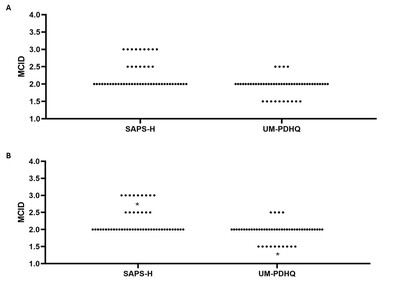Reeves, Suzanne;
Mahdi, Josef;
Appleby, Matthew;
Zubko, Olga;
Lee, Teresa;
Barber, Julie A;
Liu, Kathy Y;
... Hallucinations working group, .; + view all
(2025)
Minimal clinically important differences for
treatment of hallucinations in Parkinson’s
disease and dementia with Lewy bodies.
Psychological Medicine
, 55
, Article e93. 10.1017/S0033291725000534.

Preview |
Text (Version of Record)
Reeves_minimal-clinically-important-differences-for-treatment-of-hallucinations-in-parkinsons-disease-and-dementia-with-lewy-bodies.pdf Download (365kB) | Preview |
![[thumbnail of Figure 1.jpg]](https://discovery.ucl.ac.uk/10205259/7.hassmallThumbnailVersion/Figure%201.jpg)  Preview |
Text
Figure 1.jpg - Accepted Version Download (46kB) | Preview |
Preview |
Text
Reeves_Table 1 Delphi survey expert clinicians.pdf Download (134kB) | Preview |
Preview |
Text
Reeves_Table 2 case scenarios expert researchers.pdf Download (157kB) | Preview |
Preview |
Text
Reeves_Table 3 Case scenarios Round 3.pdf Download (139kB) | Preview |
Preview |
Text
Reeves_Table 4 Anchor and distribution based approaches.pdf Download (132kB) | Preview |
Preview |
Text
Reeves_CHANGES TO Supplementary Information 1_Hallucinations working group names.pdf Download (99kB) | Preview |
Abstract
Background: Hallucinations are common and distressing symptoms in Parkinson’s disease (PD). Treatment response in clinical trials is measured using validated questionnaires, including the Scale for Assessment of Positive Symptoms-Hallucinations (SAPS-H) and University of Miami PD Hallucinations Questionnaire (UM-PDHQ). The minimum clinically important difference (MCID) has not been determined for either scale. This study aimed to estimate a range of MCIDs for SAPS-H and UM-PDHQ using both consensus-based and statistical approaches. / / Methods: A Delphi survey was used to seek opinions of researchers, clinicians, and people with lived experience. We defined consensus as agreement ≥75%. Statistical approaches used blinded data from the first 100 PD participants in the Trial for Ondansetron as Parkinson’s Hallucinations Treatment (TOP HAT, NCT04167813). The distribution-based approach defined the MCID as 0.5 of the standard deviation of change in scores from baseline at 12 weeks. The anchor-based approach defined the MCID as the average change in scores corresponding to a 1-point improvement in clinical global impression-severity scale (CGI-S). / / Results: Fifty-one researchers and clinicians contributed to three rounds of the Delphi survey and reached consensus that the MCID was 2 points on both scales. Sixteen experts with lived experience reached the same consensus. Distribution-defined MCIDs were 2.6 points for SAPS-H and 1.3 points for UM-PDHQ, whereas anchor-based MCIDs were 2.1 and 1.3 points, respectively. / / Conclusions: We used triangulation from multiple methodologies to derive the range of MCID estimates for the two rating scales, which was between 2 and 2.7 points for SAPS-H and 1.3 and 2 points for UM-PDHQ.Methods: A Delphi survey was used to seek opinions of researchers, clinicians and people with lived experience. We defined consensus as agreement ≥75%. Statistical approaches used blinded data from the first 100 PD participants in the Trial for Ondansetron as Parkinson’s Hallucinations Treatment (TOP HAT, NCT04167813). The distribution-based approach defined the MCID as 0.5 of the standard deviation of change in scores from baseline at 12 weeks. The anchor-based approach defined the MCID as the average change in scores corresponding to a 1-point improvement in clinical global impression-severity scale (CGI-S). Results: Fifty-one researchers and clinicians contributed to three rounds of the Delphi survey and reached consensus that the MCID was 2 points on both scales. Sixteen experts with lived experience reached the same consensus. Distribution-defined MCIDs were 2.6 points for SAPS-H and 1.3 points for UM-PDHQ, whereas anchor-based MCIDs were 2.1 and 1.3 points, respectively.
| Type: | Article |
|---|---|
| Title: | Minimal clinically important differences for treatment of hallucinations in Parkinson’s disease and dementia with Lewy bodies |
| Location: | United Kingdom |
| Open access status: | An open access version is available from UCL Discovery |
| DOI: | 10.1017/S0033291725000534 |
| Publisher version: | https://doi.org/10.1017/S0033291725000534 |
| Language: | English |
| Additional information: | © The Author(s), 2025. Published by Cambridge University Press his is an Open Access article, distributed under the terms of the Creative Commons Attribution licence (http://creativecommons.org/licenses/by/4.0), which permits unrestricted re-use, distribution and reproduction, provided the original article is properly cited. |
| Keywords: | Minimum clinical important difference, SAPS-H, UM-PDHQ, hallucinations, Parkinson’s disease, dementia with Lewy bodies, Delphi consensus |
| UCL classification: | UCL UCL > Provost and Vice Provost Offices > School of Life and Medical Sciences UCL > Provost and Vice Provost Offices > School of Life and Medical Sciences > Faculty of Brain Sciences UCL > Provost and Vice Provost Offices > School of Life and Medical Sciences > Faculty of Brain Sciences > Division of Psychiatry UCL > Provost and Vice Provost Offices > School of Life and Medical Sciences > Faculty of Brain Sciences > Division of Psychiatry > Mental Health of Older People |
| URI: | https://discovery.ucl.ac.uk/id/eprint/10205259 |
Archive Staff Only
 |
View Item |


